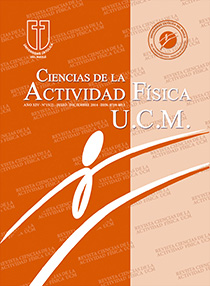American College Sport Medicine (ACSM). (2006). Guidelines for exercise testing and prescription. Seventh edition, Phildelphia: Lippincot Williams & Wilkins.
Amercian Heart Association. (1972). Exercise testing and training of apparently healthy individuals: a handbook for physicians. Nueva York, 15.
Aranguiz, H., García, V., Rojas, S., Salas, C., Martínez R. & Mac Millan, N. (2010) Estudio descriptivo, comparativo y correlacional del estado nutricional y condición cardiorrespiratoria en estudiantes universitarios de Chile. Rev. Chil. Nutr. 37(1) 70-78.
Astrand, P. (1965). Work test with the bicycle ergometer. Varberg, Sweden: AB CylkelfabrikenMonark.
Astrand, P. &Rodahl, K. (1996). Fisiología del trabajo físico. Bases fisiológicas del ejercicio. 3° Edición. Buenos Aires: Argentina, MedicaPanamericana.
Bayati, M., Farzad, B., Gharakhanlou, R. & Agha-Alinejad H. (2011) A practical model of low volume high intensity interval training induces performance and metabolic adaptations that resemble all out sprint interval training. Journal of Sport Science and Medicine 10:571- 6.
Booth, F., Gordon, S., Carlson, C. & Hamilton, M. (2002)Waging war on modern chronic diseases: primary prevention through exercise biology. J Appl Physiol. 88:774-87.
Centro de Estudios del Ministerio de Educación (2012). Inclusión del ranking en el proceso de admisión 2013: ¿Favorece realmente la equidad? SerieEvidencias, Año 1, N° 7.
Cooper, K. (1982). The aerobics way. New York: Bantam Books, Inc.
Díaz, E., Mesa, J. & Saavedra, C. (2008). Manual de ejercicio para la prevención y control de enfermedades crónicas. Ministerio de Salud.
Díaz, E., Saavedra, C., Lira, M., Bustos, E. & Rivera, I. (2008) Evaluación de la condición física en adultos chilenos. Informe final. Rev Cs Deporte del IND. 3:7-13.
García- Soidán, J. & Fernández, A. (2010) Valoración de la condición física saludable en universitarios gallegos. Rev. Int. Med. Cienc. Act. Fis. Dep. 11(44) 781-790.
Kalichman, L., Livshits, G. & Kobyliansky, E. (2004). Association between somatotypes and blood pressure in an adult chuvasha population. Ann Hum Biol. 31: 466–76.
International Society for the Advancement of Kinanthropometry (ISAK). (2008). Manual de kineantropometría.
Mc Ardle, W., Katch, F. &Katch, V. (2010) Exercise physiology. 7° Ed. Editorial Baltimore.
Mendoza, R., Sospedra, I.,Sanchis, I., Mañes, J. & Soriano, J. (2011). Comparación del somatotipo, evaluación nutricional e ingesta alimentaria entre estudiantes universitarios deportistas y sedentarios. MedClin (Barc).
Melo, G. & Rueda, O. (2007) Evaluación de la composición corporal y la capacidad aerobia en una muestra de estudiantes universitarios de Bucaramanga en el 2005. Salud UIS: 39:84-97.
Ortega, R., Requejo, A., López- Sobaler, A., Navia, B., Perea, J., Mena M, et al. (2000). Conocimiento con respecto a las características de una dieta equilibrada y surelación con los hábitos alimentarios de un colectivo de jóvenes universitarios. NutrClin. 5:195–201.
Rodríguez, F.A. & Aragonés, M.T. (1992). Valoración funcional de la capacidad de rendimiento físico. En: Fisiología de la actividad y del deporte. Madrid: interamericana/Mc Graw- Hill. 237- 278.
Sharkey, BJ. (2002). Fitness & Health. Fifth Edition. Human Kinetics, Hong Kong.
World Health Organization (1999).The use and interpretation of Anthropometry. WHO. Technical report series. N. 854. Geneva.


